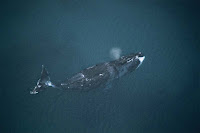Surprisingly, the whales’ recovery has actually accelerated as the Arctic warms, according to an update on the species published this week by the National Ocean and Atmospheric Administration.
“This is really one of the great conservation successes of the last century,” said J Craig George, a retired biologist with the North Slope borough department of wildlife management.
Bowhead whales – the only baleen whale that lives in the Arctic year-round – were once on the brink of disappearing forever. The population near Alaska was targeted by commercial whalers beginning in the 1700s for their oil, blubber and baleen. Their large, rotund bodies and slow-moving nature made them easy targets, and they were nearly hunted to extinction by the turn of the 20th century.
Once commercial whaling ceased, the western Arctic population living in the Bering, Chukchi and Beaufort seas began to rebound. The whales’ recovery has been in large part thanks to the natural inaccessibility of their ice-covered home, which has shielded them from commercial shipping and fishing activities that threaten their right whale cousins to the south.
George also credits sustainable management and stewardship of the Alaska Eskimo Whaling Commission (AEWC), who have fought against offshore oil drilling and other activities that could harm the species.
“No one has fought harder than the AEWC to protect bowhead habitat from industrial development in the US Arctic,” George said.
Researchers work with Alaska native communities such as the Inupiat of Utqiaġvik, Alaska, who have hunted the whales at sustainable levels for at least 1,000 years, to monitor and study the species. “The general understanding of cetacean biology, anatomy and physiology and ecology has been greatly enhanced in the partnership with indigenous hunters,” George said. “It was the Inupiat captains that taught us how to properly count whales.”
Bowhead whales can provide broader insights into Arctic marine ecosystem health. The species’ longevity and sensitivity to annual fluctuations help biologists track changes in the Arctic over long periods of time.
Bowhead whales’ accelerated population expansion in recent decades has come as a surprise to biologists, who expected the cold-adapted whale species to suffer from the melting sea ice. Bowheads are highly specialized to their Arctic environment, with a pronounced bump on their heads used to break ice and blubber over a foot and a half (half a meter) thick. So far, however, the whales have proven resilient in the face of dramatic changes and have even benefited in unexpected ways.
The Arctic is becoming more productive as temperatures rise and more light reaches the ocean surface layer where sea ice is thinner or absent. Less ice and more nutrients flowing north from the Bering Sea have led to an increase in bowhead whale foods like krill and copepods in northern latitudes. These changes have been helpful to bowheads around Alaska, resulting in fatter whales and more babies, according to Noaa.
Bowheads have also been able to expand their territory north into waters where the ice was once too thick for them to break. While the western Arctic population was hunted down to just a few thousand individuals by the end of commercial whaling, they had rebounded to about 10,000 individuals by the turn of the 21st century and now number at least 16,800.
by Rachel Fritts, The Guardian | Read more:
Image: Flip Nicklin/FLPA[ed. I started my career in the late 70s studying the Bering Straits and developing regulations to protect bowhead whales. I've eaten them and they are definitely an accquired taste.]
